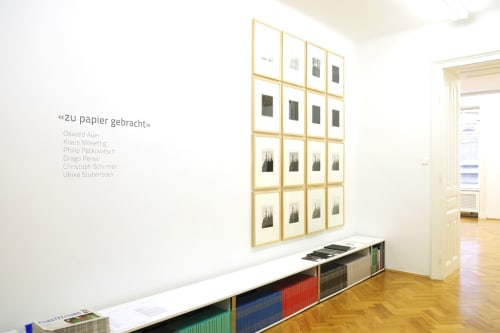The exhibition ‘zu papier gebracht’ shows six different artistic positions that all deal intensively with the medium of paper.
Oswald Auer, for example, deals with the classic theme of dot etching in his art. Plates meticulously worked in the mezzotint technique are elaborately printed, condensed and also thinned out again, as in the ‘Milan Cathedral’ series: 16 prints show the ‘disappearance’ and ‘reappearance’ of this Italian landmark. From the exact depiction of the cathedral to its concealment, which is then reversed in an elaborate process: The ‘Zumalung’ is detached from the plate again, allowing the Italian landmark to shine once more as the final image. In the ‘Sea without Water’ series, Auer translates the barren desert floor onto paper.
Klaus Mosettig's works are pencil drawings on paper. They are based on well-known works of art from art history or, in contrast, on everyday motifs from nature - something alien and sometimes discarded: ‘At the other end of the scale is a highly ironic series of cow pats, whose opulent obsession with detail allows random nature to coagulate into monumental art,’ says Rolf Wienkötter in ‘Vom Zeichen in der Zeit, Klaus Mosettigs abstrakter Blick auf das Konkrete’. Mosettig translates ‘truly’ monumental art into his ‘Pollock drawings’, for example: The quick, gestural painting of a Jackson Pollock's action painting is translated into a finely detailed drawing that takes weeks to create. The basic idea of the original work is thus reduced to absurdity: The image is projected and transferred to the medium of paper in black and white nuances.
The winner of the STRABAG Artaward International 2013, Philip Patkowitsch, makes use of classical drawing and printmaking. He borrows his motifs from well-known media such as comics - in the exhibition it is the Joker from Batman and Robin - or from the genre of Hollywood cinema. The portraits depicted are alienated in that a seemingly two-dimensional abstraction ‘creeps’ over the image. His works are mostly to be understood as series of drawings based on well-known quotations, which Patkowitsch likes to utilise. His pictures thus often raise questions and challenge the viewer to engage with what is shown on several levels.
Drago Persic looks for his models in the staging, often drawing on masterpieces from art history, such as ‘Antiochus et Stratonice’ by Ingres in the work on display. The transfer to the medium of paper takes place in a grisaille painting. Black and white oil paint is used in such a way that the often banal object takes on an almost old-masterly, historical significance. Through his meticulously transferred direction of light, the sometimes small works on paper become almost powerful: they tell a story and the viewer gets to feel a Patos that hovers between hyperrealism and open painting: the truly ‘pictorial’ curtain is lifted.
Christoph Schirmer's works on paper are structured and at the same time they explode this structure. Executed in mixed media, the artist uses an abstract visual language in his works: lines cover the paper, paired with free surfaces. Clarity and geometric shapes thus create a depth in the image that can be interpreted in the classical sense. And then, suddenly, this angularity breaks up and allows forms to emerge that are reminiscent of ornaments or even flora and fauna. There is movement and dynamism on the paper, which leads to a visual break. A pictorial language emerges that leaves us marvelling: There are few limits to discovery. Florian Steininger describes this as follows: ‘The statically clear image of reality gives way to a grid broken by speed.’
The grid also occupies Tyrolean artist Ulrike Stubenböck. However, her grid is characterised by randomness and movement. She applies individual brushstrokes in acrylic to the paper and lets the colour on the brush tool become less and less: the strokes become more permeable, diminish in their appearance and thus show a nuance from dark to light in the overall view of the paper. In her latest works, the artist explores the theme of macro photography. As an enthusiastic observer of nature, she takes models from the plant world and transfers them freely and gesturally to the medium of paper. This is not based on an exact likeness - as in Mosettig's work - but rather on the transfer of an image, a feeling, that has taken root in her. Sensitive abstract works are created.







